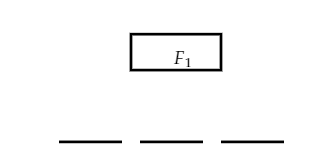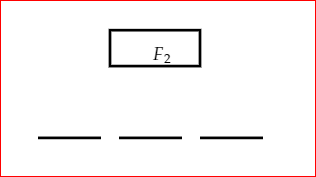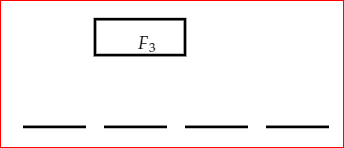
Two families with three members each and one family with four members are to be seated in a row. In how many ways can they seat so that the same family member is not separated?
A.\[2!3!4!\]
B.\[{\left( {3!} \right)^3}4!\]
C. \[3!{\left( {4!} \right)^3}\]
D. \[{\left( {3!} \right)^2}4!\]
Answer
218.4k+ views
Hints Here it is given that three families have to sit in a row, the first family consists of 3 members, the second family also consists of 3 members and the third family consists of 4 members. First, obtain 3 families can seat in how many ways, then obtain that, 3 members of a family can seat in how many ways, after that obtain the result for other two families as well. Then multiply all the obtained ways to get the required answer.
Formula used
A family of n members can seat in a row in n! ways.
Complete step by step solution
There is three families. We can arrange them without separating them.

Image: Arrange three families
The number of ways to arrange three families is 3!
There are three members in the first family.

Image: Seats for first family
They can seat any one of the seats out of the four seats.
If one member of the family occupies the first seat, then the second member has only two choices of the seat and the third member has only one choice.
Now, three members of the first family can seat in \[3 \times 2\times 1\]= 3! ways.
There are three members in the second family.

Image: Seats for the second family
They can seat any one of the seats out of the four seats.
If one member of the family occupies the first seat, then the second member has only two choices of the seat and the third member has only one choice.
Now, three members of the second family can seat in \[3 \times 2\times 1\]= 3! ways,
There are four members in the third family.

Image: Seats for the third family
They can seat any one of the seats out of the four seats.
The first member has four choices to select a seat, the second member has only three choices to select a seat, the third member has two choices to select a seat, and the fourth member has only one choice to select a seat.
Now, three members of the third family can seat in \[4 \times 3 \times 2\times 1\]= 4! ways,
The total number of favorable arrangements = Arrangements of the families \[\times\] Arrangement of family members.
Therefore, the required result is,
\[3! \times 3! \times 3! \times 4!\] ways.
That is, \[{\left( {3!} \right)^3}4!\] ways.
The correct option is B.
Additional information: Here in the given problem, we are using the concept of combination. First, we obtain the in how many 3 families can seat then we obtain that in how many ways the family members of each family can seat to obtain the required answer.
Note: Students often do not consider the arrangements of the family to solve the question. They only focus on the arrangement of the family members. To solve this problem, we have to consider the arrangement of the family.
Formula used
A family of n members can seat in a row in n! ways.
Complete step by step solution
There is three families. We can arrange them without separating them.

Image: Arrange three families
The number of ways to arrange three families is 3!
There are three members in the first family.

Image: Seats for first family
They can seat any one of the seats out of the four seats.
If one member of the family occupies the first seat, then the second member has only two choices of the seat and the third member has only one choice.
Now, three members of the first family can seat in \[3 \times 2\times 1\]= 3! ways.
There are three members in the second family.

Image: Seats for the second family
They can seat any one of the seats out of the four seats.
If one member of the family occupies the first seat, then the second member has only two choices of the seat and the third member has only one choice.
Now, three members of the second family can seat in \[3 \times 2\times 1\]= 3! ways,
There are four members in the third family.

Image: Seats for the third family
They can seat any one of the seats out of the four seats.
The first member has four choices to select a seat, the second member has only three choices to select a seat, the third member has two choices to select a seat, and the fourth member has only one choice to select a seat.
Now, three members of the third family can seat in \[4 \times 3 \times 2\times 1\]= 4! ways,
The total number of favorable arrangements = Arrangements of the families \[\times\] Arrangement of family members.
Therefore, the required result is,
\[3! \times 3! \times 3! \times 4!\] ways.
That is, \[{\left( {3!} \right)^3}4!\] ways.
The correct option is B.
Additional information: Here in the given problem, we are using the concept of combination. First, we obtain the in how many 3 families can seat then we obtain that in how many ways the family members of each family can seat to obtain the required answer.
Note: Students often do not consider the arrangements of the family to solve the question. They only focus on the arrangement of the family members. To solve this problem, we have to consider the arrangement of the family.
Recently Updated Pages
The maximum number of equivalence relations on the-class-11-maths-JEE_Main

A train is going from London to Cambridge stops at class 11 maths JEE_Main

Find the reminder when 798 is divided by 5 class 11 maths JEE_Main

An aeroplane left 50 minutes later than its schedu-class-11-maths-JEE_Main

A man on the top of a vertical observation tower o-class-11-maths-JEE_Main

In an election there are 8 candidates out of which class 11 maths JEE_Main

Trending doubts
JEE Main 2026: Application Form Open, Exam Dates, Syllabus, Eligibility & Question Papers

Derivation of Equation of Trajectory Explained for Students

Hybridisation in Chemistry – Concept, Types & Applications

Understanding the Angle of Deviation in a Prism

Understanding Collisions: Types and Examples for Students

Understanding Atomic Structure for Beginners

Other Pages
JEE Advanced Marks vs Ranks 2025: Understanding Category-wise Qualifying Marks and Previous Year Cut-offs

NCERT Solutions for Class 11 Maths Chapter 10 Conic Sections

NCERT Solutions for Class 11 Maths Chapter 9 Straight Lines

NCERT Solutions For Class 11 Maths Chapter 8 Sequences And Series

How to Convert a Galvanometer into an Ammeter or Voltmeter

NCERT Solutions For Class 11 Maths Chapter 12 Limits And Derivatives




